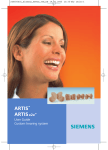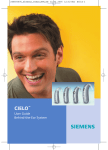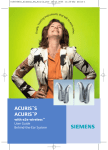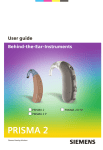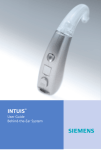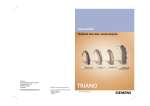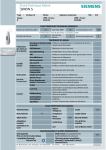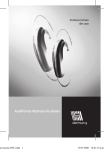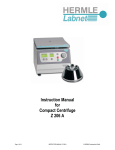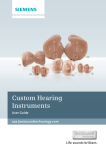Download Siemens Behind-the-Ear System Hearing Aid User Manual
Transcript
TM CENTRA User Guide Behind-the-Ear System s Congratulations ! As the owner of a new hearing system, you may once again enjoy the sounds of your environment and conversation with your family and friends. These instructions as well as support from your hearing instrument specialist will help you understand how your new hearing system works. In this guide, you’ll find instructions about insertion, removal and use of your CENTRATM hearing system. There are also tips and information on proper handling, cleaning, care and changing of the batteries. In addition, a troubleshooting section is offered for your reference. Your hearing improvement with a hearing system depends on the fit of the hearing instruments, the type and degree of hearing loss, and proper diagnostic testing. Of course, a hearing system cannot restore normal hearing, and not everyone will benefit equally. More than 80 percent of individuals with a hearing loss have a hearing loss in both ears. Studies show that even when a hearing loss is worse in one ear, most people will benefit from wearing two instruments. Remember, a hearing system consists of finely-tuned devices that have been specially designed and expertly adjusted for your individual needs. Proper care and handling will ensure the best possible performance of your CENTRA hearing system. 2 Contents Page Your CENTRA BTE (behind-the-ear) hearing system - CENTRA S and CENTRA S VC 4 - CENTRA P and CENTRA HP 5 - CENTRA SP 6 Battery insertion and removal 7 Battery compartment door lock 10 Inserting and removing your CENTRA BTE 11 Turning your CENTRA BTE on and off 12 e2e wireless TM 14 Using the program button 16 Using the directional microphone system 18 Audio input 20 Using the telephone 22 Maintenance and care 24 Important notes 25 Troubleshooting tips 26 3 Your CENTRA S and S VC BTE* hearing system CENTRA S CENTRA S VC s a a s d j g f j k g k h h Features 1. Ear hook 2. Microphone openings 3. Program button with ON/OFF function (only CENTRA S) 4. Volume control (only CENTRA S VC) 5. Cover for programming socket 6. Battery compartment with ON/OFF function 7. Color-coded typeplate red = right instrument blue = left instrument 8. Audio input * BTE – Behind-the-ear 4 Your CENTRA P and HP BTE hearing system CENTRA P CENTRA HP s a a s f d g g j f j d k k h h Features 1. Ear hook 2. Microphone openings 3. Program button with ON/OFF function 4. Volume control 5. Cover for programming socket 6. Battery compartment 7. Color-coded typeplate red = right instrumen blue = left instrument 8. Audio input For optimum fitting, CENTRA P instruments are specially designed for both the left and right ears. In addition, they are color-coded for your convenience to keep them easily apart. 5 Your CENTRA SP BTE hearing system CENTRA SP a s f g d j k h Features 1. Ear hook 2. Microphone openings 3. Program button with ON/OFF function 4. Volume control 5. Cover for programming socket 6. Battery compartment 7. Color-coded typeplate red = right instrument blue = left instrument 8. Audio input 6 Battery insertion and removal Handling the battery Remove the tab on your battery only when you are ready to use it. Three useful tips: • The positive (+) side of the battery is always the smooth side. You can recognize the negative (-) side by the colored ring. • Always keep spare batteries with you. • If you think you cannot change the battery by yourself, ask someone to help you: a family member, friend or your hearing instrument specialist. Inserting the battery Open the battery compartment with your fingernail as shown in the illustration. Swivel open the battery compartment door, if not already open. Insert a proper sized battery so that the "+” symbol on the battery matches the "+” marked on the battery compartment. 7 Close the battery compartment by gently pressing the bottom of the door upward with your finger tip. Do not force the door shut. If it does not close easily, check if the battery was inserted properly. When the battery door is completely closed, your hearing instrument is ready for use. Removing the battery In case the battery does not come out, lightly tap the system or carefully push the battery out with a pencil as shown. Low battery indicator Your hearing system may be programmed to inform you when the battery should be replaced for best system performance. You may hear an intermittent series of beeps and/or experience low amplification power or volume. Change the battery when either of these occurs. When using a remote control If you have an ePocketTM remote control, you can check the battery status using the "data read out” function. (See the ePocket user guide for more information). 8 Caution: Keep batteries and instruments away from the reach of small children. Batteries can be harmful if swallowed. If swallowed, consult a physician or a hospital immediately. Change the batteries when any of the following occur: - Volume becomes softer or weak. - You hear a battery signal beep. - You see empty battery status on the display of your ePocket. Do NOT throw used batteries into household trash. Return them to your hearing instrument specialist for environmentally correct disposal. 9 Battery compartment door lock Your instrument is equipped with a battery compartment door lock to prevent the unintentional removal of the batteries. To lock the battery compartment, open the compartment door to the first stop. Push the slide to the right with a suitable tool. To unlock the battery compartment, open the compartment door to the first stop. Push the slide to the left with a suitable tool. If necessary, your hearing instrument specialist can further instruct you on the use of this feature. 10 Inserting and removing your CENTRA BTE Make sure that your hearing instrument is turned off. Hold the earmold between your thumb and index finger and insert it carefully into your ear canal. You may find it helpful to pull your ear slightly upward or to the back. Gently work the earmold into its proper position by adjusting it until it is firmly seated in your ear. Once inserted, you should be able to feel if the ear mold is placed correctly. Next, place your hearing instrument behind your ear and turn it on. Tip: Practice inserting and removing your hearing instrument correctly. An easy way to practice is to sit down at a table. Place a mirror in front of you and prop your elbows on the table so you can guide your hands easily and safely. This will help you stay relaxed and comfortable while you practice. 11 Turning your CENTRA BTE ON and OFF Via the battery compartment Your CENTRA hearing system turns on automatically when a battery is inserted and the compartment door is completely closed. To turn OFF Press the battery compartment in the rear down to the first stop to turn the hearing instrument OFF. To turn ON Fully close the battery compartment to turn the hearing instrument ON. 12 Via the push button Your hearing instrument specialist can also program your hearing system to be turned ON and OFF using the program button. To turn your hearing instrument OFF, press and hold the program button for approximately 2 seconds. To turn your hearing instrument ON again, press and hold the program button for approximately 2 seconds. Please note that when you turn your hearing instrument OFF using the program button, you must wait approximately 10 seconds for the instrument to reset before you can turn it back ON again using the program button. Check with your hearing instrument specialist which ON/OFF function your hearing system is equipped with. Power-on delay Your hearing instrument is equipped with a "power-on delay" feature. This feature delays sound from entering your hearing instrument when it is first turned on, so that you may insert the hearing instrument into your ear without experiencing unpleasant feedback (whistling). The "power-on delay" can be activated by your hearing instrument specialist. 13 e2e wirelessTM for CENTRA hearing systems Unique to your CENTRA hearing system is the e2e (ear-to-ear) wireless technology. This wireless functionality... ... automatically adjusts both of your hearing instruments simultaneously to different listening situations. ... allows use of accessories including the ePocket (bi-directional remote control) function. ... provides synchronization of the settings in the system. If you change the volume or program on one hearing instrument, the other is automatically adapted. Your hearing instrument specialist can activate or deactivate the e2e wireless functionality of your hearing system. The ePocket function can be activated or deactivated separately. Note: The performance of the e2e wireless could be affected by electro-magnetic interferences, such as a computer monitor or halogen lamp systems controlled by a switching power supply. Move away from the source of interference if you experience difficulty. 14 ePocketTM accessory for CENTRA hearing systems Wireless remote control – ePocket (accessory) The e2e wireless function of your CENTRA hearing system supports ePocket, the bi-directional remote control from Siemens. With ePocket, you can change the program and volume of your hearing system and read out the system settings. For further information on ePocket, contact your hearing instrument specialist or refer to the ePocket user guide. Note: In case another person’s remote control unit (RCU) interferes with your hearing aid, please return your RCU and hearing aid to the service department for change of the transmission key. During the use of the wireless link while the instrument is operated in telephone coil mode, pulsing noise may be heard due to pick-up of the transmission signal by the hearing aid telephone coil. Please use remote control in telephone coil mode only with a distance greater than 10 cm. 15 Using the program button How to select the programs Your CENTRA hearing system offers up to four hearing programs for specific listening environments. They change the characteristics of the sound coming through the hearing system. Select a program using the program button of your hearing aid or by attaching an audio shoe. Each time you press the program button, your hearing system switches to the next program, confirming each change with a beep. The number of beeps you hear coincides with the selected program: one beep for the first program, two beeps for the second program etc. When you attach an audio shoe, the hearing system automatically switches to program 4. The program button can be programmed for special functions: Audio shoe: Is the audio shoe attached, you can use the program button to change between the different audio shoe modes (only audio shoe, mix mode of audio shoe and microphone or only microphone mode). 16 Telephone coil: When you hold a telephone receiver to your CENTRA hearing instrument, the telephone program AutoPhone is automatically activated by the magnetic field of the receiver. Ask your hearing instrument specialist about these functionalities and he will program your CENTRA hearing system to your individual needs. Note: For e2e wireless function: If you are wearing two hearing instruments, the program will be changed on both instruments at the same time. Hearing program Description of the hearing situation 1 2 3 4 Functionality Mode Audio shoe AutoPhone 17 Using the directional microphone system Your CENTRA hearing system has a directional microphone system, which can be programmed to your individual needs. It can be set to an automatic mode so the CENTRA hearing system automatically adjusts the microphone system from omni-directional to directional mode and back, depending on the hearing situation. For example: A typical situation for the directional mode is a face-to-face conversation in a noisy environment. A typical situation for the omni-directional mode is when you are in more quiet environments and want to hear the sounds around you. Your hearing instrument specialist will program the operation of the directional microphone system to function either automatically or in conjunction with the program button based on your individual hearing requirements and preferences. If the directional microphone system is not programmed to function automatically, your hearing instrument specialist can instruct you on its use. 18 Using the volume control Rotate the wheel upwards to increase volume. Rotate it down to decrease volume. All CENTRA hearing systems have manual volume control, except the CENTRA S. In general, volume control of CENTRA hearing systems is fully automatic and there is no need to manually adjust the volume. Should you prefer manual volume control, however, CENTRA hearing systems can be programmed for manual adjustment. For manual adjustment, rotate the wheel-shaped volume control with your index finger to select the desired listening volume (up for louder, down for softer). If your hearing system is equipped with a warning tone for volume control limits, once it is heard, adjusting the volume control further in that direction will have no effect. Learning function CENTRA hearing instruments memorize changes made in volume control settings. They are evaluated, averaged, and automatically applied. This means that over time your hearing instrument automatically adapts to your preferences regarding the volume setting for each program. If your hearing system has not been programmed for manual control adjustment, the volume will automatically adjust and rotating the volume control wheel will have no effect. Note: With the ePocket remote control, volume settings can be adjusted and memorized on all systems. If you are wearing two hearing instruments, the volume will be changed on both instruments simultaneously. 19 Audio input Your hearing system is equipped with audio input capability. This enables the connection between the hearing system and accessories such as an FM system, tape recorder, television-, or an infrared device. It can be useful for adults in difficult listening situations and for children in classrooms. Because the sound is coming directly from the sound source to the hearing system, the signal is clearer and unaffected by poor room acoustics. Note: You can only use audio shoes designed exclusively for CENTRA hearing systems. Hearing system Printed sign at the inner side* “F5” CENTRA S “F5” CENTRA S VC “F5” CENTRA P “F5” CENTRA HP “L6” CENTRA SP * Which can be seen when looking from the top into the audio shoe. Small recess in the hearing system housing only CENTRA SP 20 Nib in the audio shoe Before the audio shoe can be attached to the hearing system, the following steps have to be fulfilled: 1. Open the battery compartment. 2. Open the audio shoe cover. 3. Close the battery compartment. Attaching the audio shoe Slide the audio shoe to the inner side of the hearing system housing until it snaps into the end position. Only for CENTRA SP: The audio shoe cover has a guideway which helps to attach the audio shoe. Removing the audio shoe To remove the audio shoe, slide the audio shoe in the opposite direction. With the audio shoe attached, the battery compartment switch is disabled and the hearing system can only be switched off with the push button. Your hearing instrument specialist can further instruct you on the use of the audio input, and provide information regarding audio input accessories such as audio shoes and cords. Safety instructions for hearing systems with audio input The audio input may be connected to line-operated equipment only if the equipment fulfills the safety requirement IEC 65 / DIN VDE 0860. 21 Using the telephone Automatic telephone program With the AutoPhone function, your CENTRA hearing system will automatically switch to the telephone program when you hold a hearinginstrument-compatible telephone receiver to your hearing instrument. When you have finished speaking on the phone and you move the telephone receiver away from the hearing instrument, it will automatically return to the previously used hearing program. You can also select the telephone program manually by using the program button. The telephone program can be set to microphone mode or telephone coil mode. Your hearing instrument specialist will program your hearing system to your individual requirements. AutoPhone magnet accessory Some telephones produce a magnetic field strong enough to automatically activate the AutoPhone function. Most types of telephones, however, require a small magnet, which is available as an accessory and can be attached to telephone receivers to activate the AutoPhone function. Ask your hearing instrument specialist about this accessory and if it is right for your hearing care needs. 22 Note: Magnets can pose risks to electronics and magnetic storage mediums when placed in close proximity. Take care not to set magnets near computers, color monitors, television sets, floppy discs, credit cards, video/audio tapes, and other electronic equipment. Keep magnets away from the reach of children. If swallowed, consult your physician. Magnets may interfere with the operation of life supporting systems (i.e. pace-makers, magnetic valves etc). Use a magnet only if not in doubt about the safe distance. The safe distance between pacemaker and magnet should be at least 10 cm (4 inch). 23 Maintenance and care Your new CENTRA hearing system is a highly sensitive system. Proper care and handling will ensure the best possible performance. Earwax may accumulate on your earmold. If not cleaned regularly you can damage the hearing system or cause health problems. Therefore: 1. It is essential to detach the earmold from your behind-the-ear system and then place it in the cleaning bath. Caution: Do NOT put the hearing system in water, only the earmold. 2. Occasionally bring your hearing system to your hearing instrument specialist to have the hearing tube changed and the system checked. Care tips: • You should place your hearing system in a "dry aid kit" with a special moisture-attracting capsule overnight. The drying capsule draws damaging moisture out of the system. Always store your hearing system in the case provided. 24 • Your hearing instrument specialist can provide you with special care sets and drying capsules to keep your hearing system in good condition. Important notes • Never expose your hearing system to extreme temperatures or high humidity. Do not store it in direct sunlight. Do not wear it when taking a shower or when applying hairspray. • As with all electrical, non gas-encapsulated systems, the hearing system must not be operated in explosionendangered rooms. • Do not wear your hearing system during short-wave therapy-, or if you work with medical treatments that use strong magnetic or high-frequency fields, such as magnetic resonance tomography, X-rays or microwave oven. • Make sure to turn your hearing system off when not in use. This helps preserve your batteries. • When not wearing your hearing system for long periods of time, remove the batteries. This prevents leakage, which can sometimes occur in batteries. Replace batteries that have a leakage immediately. • This device complies with Part 15 of the FCC Rules. Operation is subject to the following two conditions: (1) this device may not cause harmful interference, and (2) this device must accept any interference received, including interference that may cause undesired operation. • Changes or modifications not expressly approved by the party responsible for compliance could void the user's authority to operate the equipment. 25 Troubleshooting tips Your CENTRA hearing system is an extremely reliable device. However, should a problem occur, it can usually be corrected quickly. This troubleshooting guide helps you to sort out simple problems. PROBLEM CAUSE POSSIBLE SOLUTION System sound is weak Weak or dead battery Replace with new battery System clogged Clean ear mold Volume too low Turn up volume control Improper seating in ear Try reinserting the instrument until it fits securely Volume control too high Lower volume control System whistles Clogged with wax or Clean ear mold or contact excessive wax in your hearing instrument ears specialist Crack in ear mold tubing 26 See your hearing instrument specialist PROBLEM CAUSE POSSIBLE SOLUTION Sound is distorted or intermittent Volume control too high Lower volume control Weak battery Replace battery “Buzzing” or “whistling” sound Hearing system does not work Battery compartment Gently close the is not completely battery compartment closed Weak battery Replace battery Lower volume control System not turned on Turn on system Battery compartpartment is not completely closed Gently close the battery compartment completely Dead battery Replace with new battery Battery polarity reversed Make sure battery is inserted correctly If you still encounter problems after trying these suggestions, consult your hearing instrument specialist. 27 Subject to change without prior notice. With the CE marking, Siemens confirms compliance with the European Directive 93/42/EEC concerning medical devices. 0123 Within the European Union, the marked equipment is covered by "Directive 2002/96/EC of the European Parliament and of the Council of 27 January 2003 on waste electrical and electronical equipment. Amended by Directive 2003/108/EC" (WEEE). Siemens Audiologische Technik GmbH Gebbertstraße 125 91058 Erlangen Germany www.hearing-siemens.com Order-No.: A91100-M5100-1257-01-7600 Printed in Germany 0206.CG 1016 9401




























